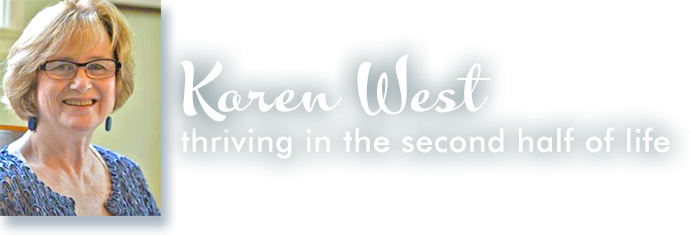{This is my fifth blog entry. I wrote the first four as an introduction to “conscious aging” and “sage-ing,” so if you are new to the topic, I suggest you read my first four entries in order.}
I can’t believe that I’ve been retired for seven years. It seems like only yesterday that I decided to make that leap. And I still can’t believe where the journey has led me. I’m constantly telling people that I credit “synchronicity” (my favorite word) for each step that I’ve taken. First, as soon as I retired, I discovered the concept of a “second half of life” when I read Falling Upward: A Spirituality for the Two Halves of Life by Richard Rohr (see Blog #1). And because someone had told me about the Osher Lifelong Learning Institute (OLLI), I also knew I could teach a class there and share my excitement about this concept. And even more amazing was the way I learned about Ron Pevny just at the right time, (see Blog #3), I was able to take his retreat, and then the most wonderful discovery of all, he told me about “sage-ing.”
When I created my first OLLI class, “Spirituality in the Second Half of Life,” I thought I was on my own. But when I learned about “sage-ing,” I discovered a community. I discovered “Sage-ing International” (sage-ing.org), and I was thrilled to become a member of this community. If you read the literature about conscious aging, you will read over and over about the importance of community for aging well.

Rabbi Zalman Schachter-Shalomi, who was responsible for beginning the sage-ing community, speaks about the importance of community in his life-changing book From Age-ing to Sage-ing. He quotes Dr. Jag Deva Singh, who said, “We need the support and encouragement that come from doing eldering work in a community of like-minded individuals.” Then Rabbi Zalman goes even further to say, “In fact, spiritual eldering {another term for conscious aging and sage-ing} initially is a search for companions, fellow travelers of this unexplored territory who share a compatible vision of human growth and lifestyle practices.” (Sage-ing, 247–8)
At another place in the book, he calls these fellow travelers “spiritual intimates.” He says, “While work like this can be done alone, we can facilitate the process by being in the company of spiritual intimates who love and accept us in our totality. Because repairing our lives is not public relations work, we need to be around people who accept us with our warts, as well as our beauty marks.” (Sage-ing, 122)
If you would like to become a part of an amazing community, I suggest that you check out the Sage-ing International website (sage-ing.org) to begin to discover all of the exciting opportunities SI offers. You can join for free and receive our newsletter. I also suggest that you consider signing up for our one-day workshop “Awakening the Sage Within,” which will introduce you to the six core topics of sage-ing: Images of Aging, Life Review, Forgiveness, Facing Our Mortality, Legacy, and Service. In August, you will be able to register for my “Awakening the Sage Within” workshop, which is a day-long workshop, on Saturday, October 12 in Minneapolis. Or if you want to begin by going deeper, you can take the weekend in-depth workshop called “Deepening the Sage Within.” You can also take the “Online Awakening the Sage Within’ in November. But if you’re not ready to take a workshop, you will find many other resources on the website and in the newsletter.
In my next blog post, I will begin discussing the first core topic of sage-ing, which is “Images of Aging.” As we grow older, many of us have negative images of aging which won’t serve us well as we become—ah, what is the word? “Elders” is the term that most writers use, but it seems that many people are not happy with that term. In upcoming posts, I will be sharing other words that some writers have chosen to use. Everyone agrees that as we are creating this new life stage, we also have to work on the language we use, but I’d like to begin by sharing what Rabbi Zalman says about how important our images of aging are. On P. 14, he says, “Aging itself isn’t the problem. It’s the images that we hold about it, our cultural expectations, that cause our problems. To have a more positive old age, we must change our aging paradigm, the model or blueprint that determines the quality of our experience. Much like software that we insert into the active memory of a computer, the program that we run dictates whether we will have a fearful, unattractive old age or a creative, fulfilling one.”
To contact me, email me at “karenw0214@gmail.com or call me at 651–399-9571. I would love to have you take a minute to let me know what you think of my blog.
Please consider registering for the “Online Awakening the Sage Within” workshop in November on the Sage-ing International website–sage-ing.org.

